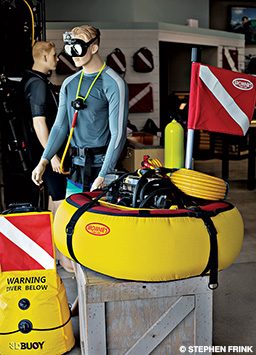Humans have been exploring the underwater world for thousands of years. What began as an endeavor limited by breath-holding ability evolved into an activity requiring advanced equipment and technology. Before the creation of the self-contained underwater breathing apparatus (scuba), Augustus Siebe in 1839 built one of the first modern dive suits: a waterproof canvas suit with a rigid dive helmet connected to a hose that supplied air from the surface. Some aspects of his primitive invention are still around today in hookah diving systems.
Like Siebe’s suit, a hookah diving apparatus provides surface-supplied air through a hose to the diver, but modern systems allow for increased mobility, convenience and safety. They are popular in recreational settings, allowing people to explore the underwater world without the bulk of a scuba unit or the need for certification. Understanding the way hookah systems work and knowing how to manage their associated risks will allow for an efficient and enjoyable hookah diving experience.
How Hookah Works
Modern hookah systems typically consist of five main parts: air reservoir tank, air filter, breathing hose, harness and regulator.

Drawing air from the surrounding environment, usually through an inlet particle filter, compressors for hookah systems use a flexible membrane (a rubber diaphragm) to compress the air, typically to pressures ranging from 30 to 50 pounds per square inch (psi), which is adequate for a single diver operating no deeper than 33 feet. If multiple divers are breathing from the same system or divers are operating at greater depth or under exertion, they require a higher pressure of air within the system. Higher-pressure compressors use pistons to compress air to about 100 psi. Although the air pressure in hookah diving is much lower than that in a scuba cylinder (about 3,000 psi), all hookah air-compressor systems have a relief valve to prevent overpressurizing the reservoir tank.
Hookah compressors can be mounted on boats, which is helpful for cleaning boat hulls, or they can be floated, allowing for divers’ increased mobility and recognition from the surface. Regardless of the compressor’s location, newly compressed air goes to a reservoir tank, where the air cools and releases moisture. Hookah systems supply air to divers through long, colorful hoses, which attach directly to the reservoir tank. The hoses are typically made of durable 3/8-inch-diameter vinyl plastic that does not kink and is positively buoyant to discourage entanglement.
The opposite end of each breathing hose connects to a one-way valve positioned on the back of a hookah diver’s harness. This valve prevents air from backflowing and prevents the hose from sucking air out of the diver’s lungs in the rare event of an air-hose breach. The other end of this one-way valve has an attachment point for a regulator hose.
Similar to a second-stage regulator, hookah regulators deliver air to the diver on demand, but they are not interchangeable with scuba regulators. The 30-50 psi of pressure supplied by a hookah system is insufficient to operate a downstream valve in a second-stage scuba regulator but presents no problem for hookah regulators, which have a more sensitive tilt or pin valve. All hookah systems are open circuit, so divers exhale bubbles into the environment whether the regulator has a mouthpiece or is attached to a full-face mask.
Risks of Hookah Diving
Although recreational hookah diving doesn’t require certification, it shares many of the same risks as scuba diving. Without a cylinder on their backs, some hookah divers forget they are still breathing compressed air and abandon the safety protocols they follow while scuba diving, such as ascending slowly or paying attention to their time spent at depth. The limited length of breathing hoses prohibits divers from exceeding their prescribed depths, but DAN®-supported research shows that hookah divers can still be at risk of decompression sickness (DCS).
In studies of hookah-using lobster divers in Isla Mujeres, Mexico, and sea-cucumber divers in the Galapagos Islands, subjects exceeded recommended safe diving limits by frequently surpassing their no-decompression limits, ascending too quickly and abbreviating their surface intervals. It is not surprising that these commercial harvesters had a higher prevalence of DCS; they dive for a living and likely pushed their limits to harvest as much as possible. DCS remains a concern, however, for recreational hookah divers who don’t adhere to appropriate limits.
Certification is not a prerequisite for hookah diving, so many hookah divers have not had training and can experience life-threatening issues if they do not receive a proper safety briefing before their dives. Along with the risk of DCS, people unfamiliar with basic scuba diving physiology may be unaware that holding their breath can result in a lung overexpansion injury or a gas embolism, causing a significant injury if they forget to exhale while ascending. Proper coaching before the dive is necessary for safe recreational hookah diving operations.
Even with proper training or predive coaching, hookah systems present some unique risks for divers using them. Perhaps the most serious risk is carbon monoxide poisoning from boat exhaust. Recreational hookah diving often takes place from boats; if a system’s compressor intakes any exhaust from the boat’s engine, it can deliver carbon monoxide directly to the divers below the surface. Breathing this colorless, odorless and tasteless gas induces hypoxia, preventing adequate oxygen delivery to tissues, the brain and other organs. Presenting first as a dull headache, dizziness or weakness, carbon monoxide poisoning may progress to loss of consciousness, irreversible brain damage or even death. It is vital that the air intake on a compressor is positioned upwind and as far as possible from an engine’s exhaust.
Hookah diving can be a safe and fun way to introduce people to the underwater world. Whether they are donning a bulky dive helmet and walking a predetermined path at a resort or exploring marine life on a shallow-water excursion, hookah divers will have a safer and more enjoyable diving experience if they understand how hookah systems work and how to manage the associated risks.
© Alert Diver — Q2 2019